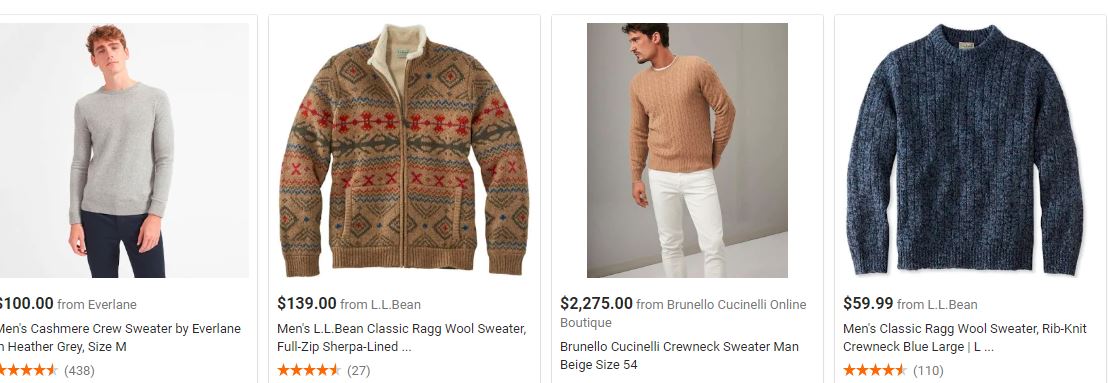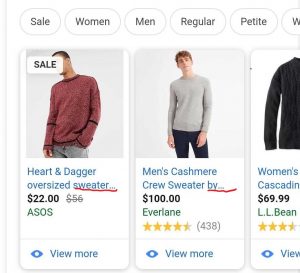You’ve setup your online clothing store on Shopify. You’ve got your inventory filled with the hottest brands. You’ve got your marketing strategy nailed. You’re ready to conquer the world.
And then: this

Somehow that needs to be turned into this:

What even is a product feed?
You can think of a product feed as essentially a massive spreadsheet with each row being a product and each column being a piece of data on that given row’s product. Think size, color, price, brand, shipping weight, etc. This spreadsheet is then sent off to various platforms such as Google Merchant Center, Shopify, Bing Merchant Center, Facebook, and Amazon. Now, the actual data can be formatted in any number of ways such as XML, JSON, plain text, but the format doesn’t change anything in terms of transformations (as long as you’re using a service). Product feeds are also being used for other text based platforms as well now, and with volume and variability of products, feeds have become a must in 2019.
Why are product feeds vital for your business?
So you have this gargantuan inventory filled with thousands of products. Each of these products in one form or another is going to be viewed by a customer — whether that be a shopping ad, a text-based ad on a search engine, a display ad, a video ad, or a social ad. This product will eventually be seen by a customer. We use a product feed to break out the individual pieces of data into every row’s columns. How these individual pieces of data on products are utilized, combined, and transformed will make the difference in whether your user clicks or even looks at your ad.
Should you use a data feed management service?
YES. Here’s why:
- Managing massive amounts of vital data and making one mistake could cause enough damage to make your worst nightmares look like heaven. Imagine accidentally setting every products price to $0.00 and accidentally shipping it off to google merchant center. On the bright side, at least your sales would skyrocket! All jokes aside, having a data feed management service gives you security in that you can apply transformations before actually pushing them out. That way, if you did accidentally set all price’s to $0.00, you could spot check your data before sending it out to your various platforms and correct the mistakes.
- Another essential reason to use a managed feed service is having the ability to apply individual transformations to your data on a per channel basis. For instance, you might want Google ads to have a different title because Google may allow more title character width, while Bing may have less title space so you may want to optimize Bing differently with the space you have. With a managed service, you can apply separate transformations for individual platforms, all while keeping the same base incoming feed. The managed service will take care of the base formatting of the data for most given platforms you choose to use, and then you apply transformations on top of their base management of the necessities for various platforms required formatting.
- Platforms are constantly changing requirements for what are considered acceptable values. One day Google may want price formatted as “<Price>US 5.00</Price>” and the next day it might change the required format to “MUNEY5DOLLAS”. Obviously they wouldn’t do something that ridiculous, but I have personally been in a disastrous situation where Google simply changed the required format for the price field and consequently one of our client’s ENTIRE FEED was shut down for days. Hundreds of thousands products just no longer being shown until we could fix the formatting days later. Using a managed data feed service can help you stay on top of any upcoming changes in the required formats for various platforms. This may sound trivial, but the peace of mind and avoidance of (most) disasters this gives you are invaluable.
It is worth noting, you will still need to keep an eye on things. Not every management service is perfect, and there can certainly be problems caused on the feed management service’s side.
11 Data Operations And Optimizations You Can Perform with Feed Management
For the purpose of example, I’m going to make up a small feed of clothing products.
| ID | Product Title | Price | Size | Gender | Brand |
| 1 | Jacket | 23.99 | L | Mens | REI |
| 2 | Sweater | 45.99 | XL | Womens | JCPenney |
| 3 | Hat | 36.99 | S | Unisex | Adidas |
| 4 | Fancy Sweater | 219.99 | M | Womens | JCPenney |
It’s always helpful to remember that a product feed is just a spreadsheet. Each row is a product. Each column is a piece of data on that product. Given the type of data in the column, there are different types of operations we can perform on that data. We also need to understand some basic logical operations to help us fine tune what we want to transform. Note that while most managed feed services will support the all of these, some may not, so make sure to do your research on which one you choose.
- Combination of Columns. This is the most important type of data transformation. Say you want your ad to include the size, gender, price, and title. Data transformations allow us to do this in any way we like. An example output might be “Female XL Sweater $45.99 20% Sale”. Obviously this isn’t a great ad, but the idea is that you have complete control to create the output of the ad based on the data for the WHOLE feed based on a single rule.
- If Conditionals. This is exactly what the name implies. We can check any column’s value (say if the product’s Gender is Female), and apply a transformation IF and only if that product is Female.
- If Conditionals Chained with ANDs. This means we could apply a transformation the sweater ad IF Size is L AND Gender is Unisex.
- If Conditionals Chained with ORs. This means we could apply a transformation to the Sweater ad IF Size is L OR Gender is Female. [Also as a side note, ANDs and ORs can also be chained together. For example: apply a transformation to the sweater ad IF (Gender is Female AND Size is XL) OR Product Title is Hat]
- Conditional Product Exclusions. Based on the conditional rules specified above, you can completely exclude certain products completely.
- Prepends and Appends. If you want to prepend some text such as a seasonal discount “20% Off For All of June” to the beginning or end your ad, you can do these.
- Replacing, Removing, and Adding Text. If there’s a piece of text you want replaced in all your titles, for instance (replace “inches” with “in.”, just a quotation mark, or just remove it completely.
- Basic Mathematical Conditionals. Say several of your products have a high price and you don’t want that to show up in the ad. With a math conditional such as greater than, you can check for all price fields greater than $200 for example and exclusively remove those prices from the ad text. Other mathematical conditionals include less than “<”, less than or equal to “<=”, greater than “>”, greater than or equal to “>=”, equal to “=”.
- Mathematical Operations. These ones are mostly self explanatory, addition, subtraction, multiplication, division, and averaging on a given row’s column value that’s a number.
- Useful Text Operations. Say for some reason the title’s in your product on capitalization is messed up “custom Designed mugs”. You can easily fix this with capitalization transformations that only capitalizes the first letter of each word and makes the rest lowercase “Custom Designed Mugs”.
- (Advanced) Regex. Regex is beyond the scope of this article, but if you need to do more complicated data transformations then the possibilities are limitless with regex. This is a great site to get started with regex.
The logic might seem a bit complicated, and depending on the scale of your feed it might seem like overkill. But once you start working with large feeds, these types of transformations are a must have. Also the first 10 operations are just the tip of the iceberg of the kind of optimizations you can do. There are also other types of operations, but while regex is the most complex to understand and apply, it really can do almost anything.
An Example Title Optimization
Given the example table above, here is an example title optimization we could make using the some of operations we discussed previously. Say we wanted the ad title to include the brand and the price, but ONLY include the price if it’s less than $100.00. We could easily do this by using an if conditional (operation 2) combined with a basic mathematical conditional (operation 8) [price < 100] to transform this title. How you apply these conditionals is dependent on the service you use, but the logic is exactly the same. (Side note, the double quotes just denote a piece of text in between those quotes. So ” ” would simply denote an empty space). The formula that we would then want would be Final Ad Title = [Gender + ” ” + Brand + ” ” + Product Title + Size + “|” + (IF Price < 100 then + ” $” + Price). This would give us the following titles:
| ID | Final Title |
| 1 | Mens REI Jacket | L $23.99 |
| 2 | Womens JCPenney Sweater | XL $45.99 |
| 3 | Unisex Adidas Hat | S $36.99 |
| 4 | Womens JCPenney Fancy Sweater | M |
This can allow us fine tuned control over things we may or may not want the customer to see initially in an ad like a high price. Even with this superficial example, you can see the massive power that data transformations can have.
Optimal Title Length for Google Shopping (and other platforms)
The optimal title length for both Google and Bing is around 60-80 characters. Google will allow up to 150, but it is recommended to keep it at or under 70 as anything after is being truncated visually. Another important reason to keep title lengths not overly long is that different devices will have vastly varying amounts of space to display your ads. This means that on mobile devices (which is probably the majority of your traffic or will be soon), there will be an even smaller amount of space for your ad, meaning more truncated title. Shoot for 60-80 characters. Some truncation is unavoidable, but the imperative thing is that most important data goes left to right, so that the least important things get truncated if they do end up being truncated. Make sure to optimize so that you’re using as much space as you can, without truncating the most vital information in your titles.

In Conclusion
Product feeds and data transformations are an absolute must in 2019. Here at Digital Position we take utmost care in managing and maintaining your feeds.






no replies